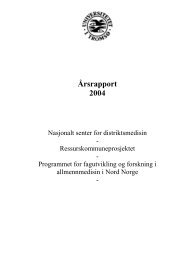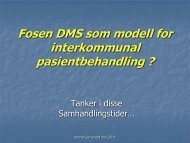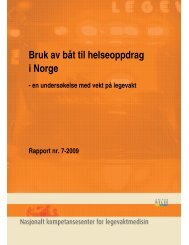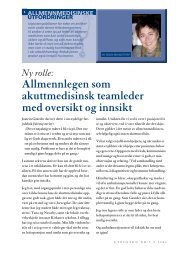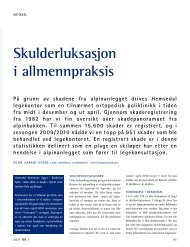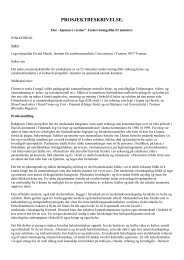Helge Garåsen The Trondheim Model - NSDM
Helge Garåsen The Trondheim Model - NSDM
Helge Garåsen The Trondheim Model - NSDM
You also want an ePaper? Increase the reach of your titles
YUMPU automatically turns print PDFs into web optimized ePapers that Google loves.
BMC Public Health 2007, 7:68<br />
http://www.biomedcentral.com/1471-2458/7/68<br />
Table 1: Baseline characteristics. <strong>Trondheim</strong> 2003–4.<br />
Assigned community hospital<br />
Assigned general hospital<br />
Intermediate care group (n = 64) Intervention group (n = 72) General hospital group (n = 70)<br />
Demography<br />
Gender<br />
Males 14 (21.9%) 20 (27.8%) 27 (38.6%)<br />
Females 50 (78.1%) 52 (72.2%) 43 (61.4%)<br />
Age males<br />
Mean (SD) 79.5 (1.5) 80.6 (1.1) 78.4 (1.2)<br />
Median 79.0 80.0 79.0<br />
Age females<br />
Mean (SD) 81.4 (1.1) 80.6 (1.1) 83.1 (1.0)<br />
Median 82.5 82.0 83.0<br />
Age both genders<br />
Mean (SD) 80.9 (0.9) 80.6 (0.8) 81.3 (0.8)<br />
Median 81.5 81.5 81.0<br />
Living with spouse<br />
Males 7 10 9<br />
Females 6 6 6<br />
ADL-scores<br />
Both genders<br />
Mean (SD 2.19 (0.1) 2.24 (0.9) 2.05 (0.7)<br />
Median 2.13 2.29 2.02<br />
Males<br />
Mean (SD 2.30 (0.2) 2.42 (0.9) 2.08 (0.1)<br />
Median 2.37 2.37 2.00<br />
Females<br />
Mean (SD) 2.17 (0.1) 2.24 (0.8) 2.05 (0.1)<br />
Median 2.10 2.18 2.03<br />
Primary diagnoses<br />
Cardiological diseases 21 (32.8%) 22 (30.6%) 20 (28.6%)<br />
Infections 7 (10.9%) 13 (18.1%) 16 (22.9%)<br />
Fractures/contusions 13 (20.3%) 14 (19.4%) 12 (17.1%)<br />
Pulmonary diseases 5 (7.8%) 5 (6.9%) 6 (8.6%)<br />
Neurological diseases 5 (7.8%) 5 (6.9%) 4 (5.7%)<br />
Cancers 2 (3.1%) 2 (2.8%) 4 (5.7%)<br />
Psychiatric diseases 1 (1.6%) 1 (1.4%) 0 (0%)<br />
Other diseases 10 (15.6%) 10 (13.9%) 8 (11.4%)<br />
and the OR between the intervention and hospital groups<br />
were 2.19 (95% CI 0.51–9.40).<br />
Number of days of care after randomisation<br />
Patients in the intervention group stayed on average 17.5<br />
days (95% CI 14.6–20.4) for initial intermediate care,<br />
10.4 days (95% CI 5.6–15.2) at rehabilitation departments<br />
and 3.1 days (95% CI 1.2–5.0) at the general hospital<br />
due to readmissions for the same disease, giving a<br />
total average of number of days with inward care after the<br />
index day of 31.0 days (95% CI 26.1–34.7) (Table 4).<br />
Patients in the general hospital group stayed 9.1 days<br />
(95% CI 6.9–11.2) at the general hospital for initial care,<br />
13.1 days (95% CI 8.2–18.1) at various rehabilitation<br />
departments and were readmitted 7.6 days (95% CI 3.6–<br />
11.6) at the general hospital, giving a total of the number<br />
of 29.8 days (95% CI 23.2–36.4) with inward care after<br />
the index day.<br />
<strong>The</strong>re was a non-significant difference in the total number<br />
of days with inward care between the patients' groups (p<br />
= 0.79), (paired t-test, using Wilcoxon signed rank test did<br />
not change the level of significance). Adjusting number of<br />
days of care for gender, age, ADL and diagnosis, there was<br />
still an insignificant difference in number of days at the<br />
institutions between the groups (p = 0.80). However,<br />
there was a significant difference in number of days of initial<br />
care in favour of the general hospital group (p = 0.00),<br />
and in number of readmission days in favour of the intervention<br />
group (p = 0.04) (Table 4).<br />
Page 5 of 9<br />
(page number not for citation purposes)




